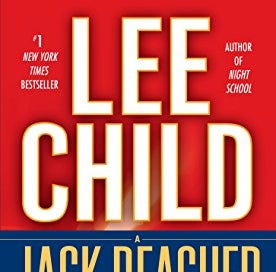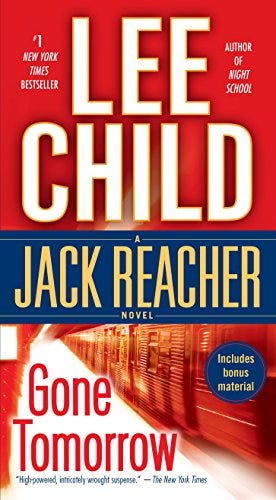Welcome to Chapter 1, where I break down the first chapter of mysteries and thrillers to figure out how they hook us—or why they fail to. If you'd like me to tackle the first chapter of your novel or WIP, just reply to this email and let me know.
The book
Gone Tomorrow by Lee Child
First line
Suicide bombers are easy to spot.
What happens?
Jack Reacher is riding a New York City subway car at two in the morning along with five other people. He’s watching one of them. A woman. He runs through a checklist developed by Israeli counterintelligence and realizes: he’s looking at a suicide bomber.
Chapter breakdown
I’m so tempted to go through the first four chapters, since they really constitute one incredibly written scene. But this is Chapter 1, and if I’m going to start cheating it won’t be in the first month of the newsletter’s existence.
So on the face of it, not much happens in this chapter. There’s a lot of description of the subway car and the people on the train. By all accounts we should be bored until the last sentence, where Reacher concludes he’s looking at a suicide bomber.
But nothing about this chapter is boring.
Why not? What makes Lee Child so damn good?
Let’s start with the first paragraph:
Suicide bombers are easy to spot. They give out all kinds of telltale signs. Mostly because they’re nervous. By definition they’re all first-timers.
The first time I read that last line I laughed out loud, mostly from admiration. When I talk about mini-payoffs, this is exactly what I mean. Make the reader laugh or even smile, and they’ll keep reading for at least another paragraph.
And in Child’s next paragraph, here’s what we get:
Israeli counterintelligence wrote the defensive playbook. They told us what to look for. They used pragmatic observation and psychological insight and came up with a list of behavioral indicators. I learned the list from an Israeli army captain twenty years ago. He swore by it. Therefore I swore by it too, because at the time I was on three weeks’ detached duty mostly about a yard from his shoulder, in Israel itself, in Jerusalem, on the West Bank, in Lebanon, sometimes in Syria, sometimes in Jordan, on buses, in stores, on crowded sidewalks. I kept my eyes moving and my mind running free down the bullet points.
Reacher is referring to a real but little-known checklist. I heard an interview with Child where he mentioned that it was the discovery of this list that gave him the idea for this novel.
One of Child’s go-to storytelling tools is to share fascinating research like this. I call this “insight.” As a reader, you feel like you’re learning something interesting about the world, and that has the same impact as humor. It’s a mini-payoff that keeps you reading.
But notice that the way Child introduces us to the list also hooks our curiosity. What’s on the list? And why is Reacher telling us this?
Child doesn’t let us know immediately. The first thing we learn about the list’s content comes a couple paragraphs later:
The list is twelve points long if you’re looking at a male suspect. Eleven, if you’re looking at a woman. The difference is a fresh shave. Male bombers take off their beards. It helps the blend in. Makes them less suspicious. The result is paler skin on the lower half of the face. No recent exposure to the sun.
Isn’t that fascinating? So much better than if we just immediately were told the twelve points on the list. Instead, we get one point, with some context setting that makes the information more satisfying. But now check out where Child takes this:
But I wasn’t interested in shaves.
I was working on the eleven-point list.
I was looking at a woman.
This is the first moment that Reacher goes from musing about suicide bombers generally to plunging us into the opening scene. And we’re brought into the scene with a surprise: the potential suicide bomber is a woman.
But we still have no idea of the setting. A common newbie mistake is white room syndrome. Usually this involves gobs of dialogue with no sense of place. People talking in a void. Child makes sure we know where the hell we are. The very next paragraph:
I was riding the subway, in New York City. The 6 train, the Lexington Avenue local, heading uptown, two o’clock in the morning. I had gotten on at Bleecker Street from the south end of the platform into a car that was empty except for five people. Subway cars feel small and intimate when they’re full. When they’re empty they feel vast and cavernous and lonely. At night their lights feel hotter and brighter, even though they’re the same lights they use in the day. They’re all the lights there are. I was sprawled on a two-person bench north of the end doors on the track side of the car. The other five passengers were all south of me on the long bench seats, in profile, side on, far from each other, staring blankly across the width of the car, three on the left and two on the right.
The more I read this paragraph the more awestruck I am by it. In less than 150 words, we have a vivid sense of time and place. It’s so damn efficient and Child makes it look easy. But notice how much he packs in there.
First, we get the big picture: we’re on a subway in New York City. That’s tells us so much—and it also acts as mini-surprise since up till now, Reacher has been talking about suicide bombers and his time in the Middle East. The last thing we expect is that we’re about to spot a suicide bomber on a New York subway.
Second, we get a sense of where in New York City the subway is (and the time of day). Readers who aren’t super-familiar with New York won’t have a clue what the Lexington Avenue local is or where Bleecker street is. But the specificity still has an impact in terms of making everything seem more real.
Then Child brings us inside the subway car. And we not only get a clear picture of how many people are inside the train and where they’re located (information that’s going to be crucial to understanding the scene as it unfolds), but we get a brilliant nugget that sets the mood: “Subway cars feel small and intimate when they’re full. When they’re empty they feel vast and cavernous and lonely.”
Notice that Child could have just said: “The empty subway car feels vast and cavernous and lonely.” That’s fine, but it’s not particularly interesting and comes across as somewhat arbitrary. But when you present the contrast between how a crowded subway car feels and how an empty one feels, a bland assertion suddenly becomes an interesting observation.
And finally, note that we also get a sense of where Reacher is. Indeed, when he paints the picture of the people on the train, he does so relative to his own position. Psychologically, that’s accurate. Reacher would be thinking of where people are in relation to him. It also prevents the paragraph from feeling like it came from the author. This isn’t Child setting the scene—this is Reacher taking in the scene.
What I’ve given you is the first two pages of the chapter. Chapter 1 goes on for just over three more pages, consisting mostly of more detailed descriptions of the train and the passengers. But what makes the descriptions work is precisely that they all subtly bring us in to Reacher’s mind.
One example:
Next up was a man on the other side, maybe four feet farther down the car. He was all alone on his own eight-person bench. He could have been from the Balkans, or the Black Sea. Dark hair, lined skin. He was sinewy, worn down by work and weather. He had his feet planted and he was leaning forward with his elbows on his knees. Not asleep, but close to it. Suspended animation, marking time, rocking with the movements of the train. He was about fifty, dressed in clothes far too young for him. Baggy jeans that reached only his calves, and an oversized NBA shirt with a player’s name on it that I didn’t recognize.
Reacher isn’t describing these people for our benefit: he’s sizing them up. The specificity makes the scene come alive for us, but that’s really secondary. The main thing that’s happening is that we’re seeing the world as Reacher does. He’s noticing every detail because that’s how he survives. As he puts it earlier in the chapter:
And my eyes still move. Pure habit. From another bunch of guys I learned another mantra: Look, don’t see, listen, don’t hear. The more you engage, the longer you survive.
So what makes Child so good? Everything gets processed through the mind of a compelling character. He bombards you with small rewards. Humor. Surprise. Curiosity. Insight. He uses specificity to pull you into a world that’s more real than the real world. And he’s hyper efficient. A paragraph is doing the work of a page. He follows Elmore Leonard’s dictum: leave out the parts that readers skip.
Bits and pieces
One of the really interesting things about Child is that he writes without an outline, and goes very slowly as he drafts, really striving for perfection. Unlike writers who adhere to the philosophy of “write a shitty draft quickly,” he writes a polished draft slowly.
I think this helps explain how incredibly efficient and methodical he is. He’s writing every sentence with intention instead of just batting out sentences with only a woozy idea of what he’s trying to say.
That doesn’t mean that you have to copy Child’s process. But what it does suggest is the value of slowing down—either in the drafting or the editing. You need to really think about how each tiny element of your story is unraveling and playing out in the reader’s mind.
We so often focus on the macro—on our overall plot—and forget that the reader takes in the story (or doesn’t) sentence-by-sentence. And that means that in the ideal story, it’s not only the overarching story that’s satisfying—it’s each and every sentence.
I don’t have a formula for accomplishing that (yet?). But I do have a mindset: try to enjoy writing every sentence. The more you’re sinking your teeth into a line or a paragraph, the more you’re not just viewing it as a means to an end but as an end in itself, the more you’ll write sentences the reader enjoys reading.
And then, when you’re editing, ask yourself of every sentence and every word: why is this here? What’s its purpose? How does it move the story forward? How does it reward the reader? Would the story become weaker or stronger if I cut it?
Lessons learned
Fill your novel with interesting research—not bland information dumps, but fascinating tidbits that reward us and draw us into your world.
Avoid white room syndrome by establishing the setting.
Specificity = reality.
Don’t tell us how something looks or feels—give us the evidence to see for ourselves how something looks or feels.
Description should tell us not just about the world, but the POV character.
Make every sentence count.
Verdict: Hooked or Cooked?
Uh, yeah…hooked. Totally.
Until next time,
D.P.




